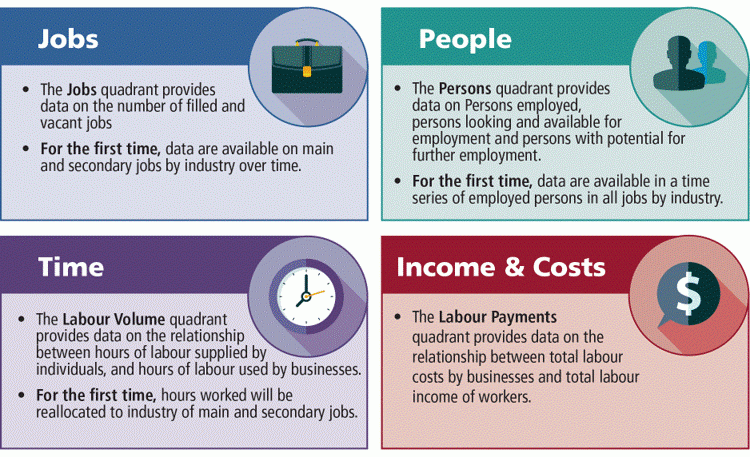Jobs measures, by industry, March quarter 2024
[{"name":"Agriculture, forestry and fishing","value":"480.10","data":[{"name":"Filled jobs","value":"477.30","data":[{"name":"Main jobs","value":"449.60"},{"name":"Secondary jobs","value":"27.70"}]},{"name":"Vacant jobs","value":"2.80"}]},{"name":"Mining","value":"234.50","data":[{"name":"Filled jobs","value":"223.70","data":[{"name":"Main jobs","value":"217.90"},{"name":"Secondary jobs","value":"5.90"}]},{"name":"Vacant jobs","value":"10.80"}]},{"name":"Manufacturing","value":"923.20","data":[{"name":"Filled jobs","value":"900.20","data":[{"name":"Main jobs","value":"872.30"},{"name":"Secondary jobs","value":"27.90"}]},{"name":"Vacant jobs","value":"23.00"}]},{"name":"Electricity, gas, water and waste services","value":"141.00","data":[{"name":"Filled jobs","value":"136.30","data":[{"name":"Main jobs","value":"133.80"},{"name":"Secondary jobs","value":"2.60"}]},{"name":"Vacant jobs","value":"4.70"}]},{"name":"Construction","value":"1261.00","data":[{"name":"Filled jobs","value":"1233.50","data":[{"name":"Main jobs","value":"1186.90"},{"name":"Secondary jobs","value":"46.60"}]},{"name":"Vacant jobs","value":"27.50"}]},{"name":"Wholesale trade","value":"630.30","data":[{"name":"Filled jobs","value":"615.00","data":[{"name":"Main jobs","value":"592.50"},{"name":"Secondary jobs","value":"22.40"}]},{"name":"Vacant jobs","value":"15.30"}]},{"name":"Retail trade","value":"1490.80","data":[{"name":"Filled jobs","value":"1455.70","data":[{"name":"Main jobs","value":"1355.30"},{"name":"Secondary jobs","value":"100.40"}]},{"name":"Vacant jobs","value":"35.10"}]},{"name":"Accommodation and food services","value":"1115.10","data":[{"name":"Filled jobs","value":"1082.40","data":[{"name":"Main jobs","value":"978.00"},{"name":"Secondary jobs","value":"104.30"}]},{"name":"Vacant jobs","value":"32.80"}]},{"name":" Transport, postal and warehousing","value":"734.80","data":[{"name":"Filled jobs","value":"724.80","data":[{"name":"Main jobs","value":"701.90"},{"name":"Secondary jobs","value":"23.00"}]},{"name":"Vacant jobs","value":"10.00"}]},{"name":"Information media and telecommunications","value":"216.10","data":[{"name":"Filled jobs","value":"212.40","data":[{"name":"Main jobs","value":"199.50"},{"name":"Secondary jobs","value":"12.90"}]},{"name":"Vacant jobs","value":"3.60"}]},{"name":"Financial and insurance services","value":"530.20","data":[{"name":"Filled jobs","value":"518.40","data":[{"name":"Main jobs","value":"476.40"},{"name":"Secondary jobs","value":"42.00"}]},{"name":"Vacant jobs","value":"11.80"}]},{"name":"Rental, hiring and real estate services","value":"327.70","data":[{"name":"Filled jobs","value":"321.90","data":[{"name":"Main jobs","value":"305.80"},{"name":"Secondary jobs","value":"16.10"}]},{"name":"Vacant jobs","value":"5.80"}]},{"name":"Professional, scientific and technical services","value":"1269.10","data":[{"name":"Filled jobs","value":"1235.60","data":[{"name":"Main jobs","value":"1166.90"},{"name":"Secondary jobs","value":"68.70"}]},{"name":"Vacant jobs","value":"33.40"}]},{"name":"Administrative and support services","value":"1087.60","data":[{"name":"Filled jobs","value":"1057.70","data":[{"name":"Main jobs","value":"908.90"},{"name":"Secondary jobs","value":"148.80"}]},{"name":"Vacant jobs","value":"29.90"}]},{"name":"Public administration and safety","value":"879.70","data":[{"name":"Filled jobs","value":"859.90","data":[{"name":"Main jobs","value":"806.00"},{"name":"Secondary jobs","value":"53.90"}]},{"name":"Vacant jobs","value":"19.80"}]},{"name":"Education and training","value":"1297.70","data":[{"name":"Filled jobs","value":"1282.30","data":[{"name":"Main jobs","value":"1142.90"},{"name":"Secondary jobs","value":"139.40"}]},{"name":"Vacant jobs","value":"15.30"}]},{"name":"Health care and social assistance","value":"2516.60","data":[{"name":"Filled jobs","value":"2450.30","data":[{"name":"Main jobs","value":"2264.80"},{"name":"Secondary jobs","value":"185.50"}]},{"name":"Vacant jobs","value":"66.30"}]},{"name":"Arts and recreation services","value":"311.80","data":[{"name":"Filled jobs","value":"306.40","data":[{"name":"Main jobs","value":"267.00"},{"name":"Secondary jobs","value":"39.40"}]},{"name":"Vacant jobs","value":"5.40"}]},{"name":"Other services","value":"583.30","data":[{"name":"Filled jobs","value":"571.00","data":[{"name":"Main jobs","value":"532.40"},{"name":"Secondary jobs","value":"38.60"}]},{"name":"Vacant jobs","value":"12.30"}]}][]
[{"axis_id":"0","tick_interval":"","axis_min":"","axis_max":"","axis_title":"","precision":-1,"axis_units":"","tooltip_units":"","table_units":"","data_unit_prefix":"","data_unit_suffix":"","reverse_axis":false}][{"value":"0","axis_id":"0","axis_title":"('000)","axis_units":"","tooltip_units":"('000)","table_units":"('000)","axis_min":null,"axis_max":null,"tick_interval":null,"precision":"-1","data_unit_prefix":"","data_unit_suffix":"","reverse_axis":false}]